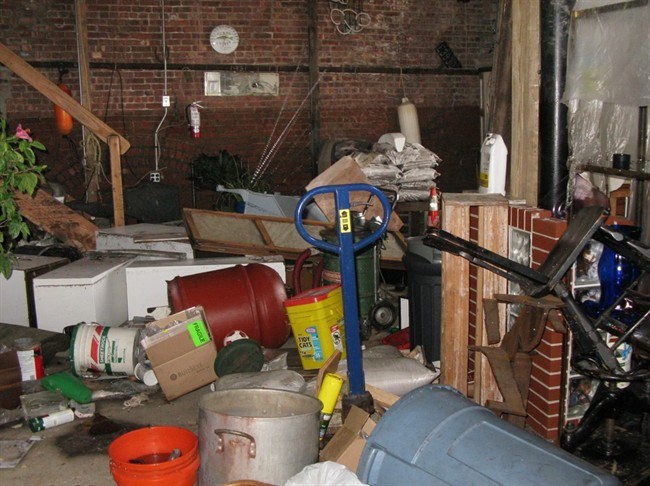NEW YORK, N.Y. - Superstorm Sandy was not kind to the arts community. It not only upended paintings, equipment, tools and paper, turning them into tangled and soggy heaps, but also the livelihoods of hundreds of artists who have helped make the New York area a dynamic art capital.
Six weeks after Sandy, Pier Glass, a studio of four glass blowers on an old pier in the Red Hook section of Brooklyn, remains without power. Corrosive salt water destroyed its furnace, scattered grinding and polishing tools, shattered glass, and destroyed historic prints.
It had also seen some water in last year's Tropical Storm Irene, but nothing like this.
"With Irene we had a few inches," said Mary Ellen Buxton-Kutch, one of its glass artists. "That you can handle. We probably could handle four feet. But over five feet was catastrophic."
Artists, galleries and lofts, many that helped bring about a renaissance in the ribbon of all-but-abandoned warehouses that line New York's coastal areas, face tens of thousands of dollars in repairs. Though no major museums reported damage, the toll among smaller operations and individual artists is steep. In response, various institutions and foundations are offering recovery help ranging from grants to free advice on how to rehabilitate damaged works of art.
Requests to the New York Foundation for the Arts for storm-related assistance total $12 million among almost 500 artists in New York and New Jersey, nearly 90 per cent of them in New York, executive director Michael Royce said.
The Craft Emergency Relief Fund, or CERF+, said it has gotten applications from 65 artists, most without insurance in devastated areas of Staten Island, Red Hook and Brooklyn's Greenpoint section where many waterfront warehouses have been turned into art studios.
Many individual artists "are still dealing with life issues and can't be thinking of earning a livelihood. Many are still really very fragile," said Craig Nutt, director of programs at CERF+, a national organization that helps professional craft artists like Buxton-Kutch through personal and natural disasters.
Pier Glass has received a grant from CERF+ and plans to seek more money from NYFA and other groups. It also plans a fundraiser even as friends have generously contributed in amounts of $1,000 and $1,500.
"You still have all your bills to pay even as you're getting this money," Buxton-Kutch said.
Apart from the studio, she and her husband, Kevin Kutch, were flooded out of their house in Brooklyn's Coney Island area and have been camping out with relatives and friends ever since the Oct. 29 storm.
Even without electricity at their studio, not working is not an option. Pier Glass does large private and public commissions and work for architects and museums, including the Metropolitan Museum of Art.
"My partner has gone to another facility to rent because we're trying to stay in business as well as rebuild," said Buxton-Kutch, who estimated the studio suffered as much as $200,000 in damage. A new furnace would cost an additional $20,000.
Nutt visited artists in Brooklyn and Staten Island in early December to assess their recovery.
"Our main concern is, what do they need to get back to work?" he said. His group has gotten calls for help from two artists in New Jersey and two on Long Island, but he expects there will be more from people still without power and unable to communicate their needs.
Royce, of NYFA, said the aid application figures likely don't scratch the surface of the thousands of artists hurt by Sandy. He reported pledges of $1.4 million to the fund, mostly through the Warhol, Rauschenberg and Lambent foundations. NYFA will seek out other donations but doesn't foresee being able to meet the amount requested, "as it continues to go up on a daily basis," he said.
The institutions that lost buildings or property include both the obscure and the well-known.
Salt water damaged some textiles and ceremonial batons at the New York City Police Museum and soaked about 60 boxes of paper archives at the New York City Opera, said Eric Pourchot, professional development director for the Foundation of the American Institute for Conservation of Historic and Artistic Works.
At Westbeth Artists Housing in Manhattan's West Village, eight feet of water inundated a labyrinth of studios in the basement of the artist colony about a block from the Hudson River, submerging paintings, sculptures and musical instruments. The adjacent Martha Graham dance company lost costumes and sets.
In New Jersey, a historic conservation group called Preservation New Jersey has reports of storm damage from 40 historical societies and house museums, some of it from falling trees and wind in addition to flooding.
Most waterlogged items can be saved, Pourchot said, but sometimes the time and the cost may be prohibitive.
"For individual artists and galleries, that's a terrifying decision," he said. "Can they be saved in such a way that they can be sold?"
Pourchot's institute has fielded 120 requests, mostly from individual artists.
"This response has been so different from anything we've been involved in," he said. "Often we can get federal funding through some of the federal arts foundations, but they are really restricted by their mandates to fund non-profit public collections. So when it came to for-profit galleries and individual artists, that's something they can't easily cough up money for."
The conservation institute and a consortium of local arts groups are putting the finishing touches on an 18,000-square-foot centre in Brooklyn where artists can get free space and expert advice to help them stabilize their collections. Even works that have been dried may still need cleaning to remove residues and mould spores.
The Cultural Recovery Center will be open three months, or longer, if necessary, Pourchot said.
The Museum of Modern Art, in collaboration with the institute, also has issued a guide on how to conserve works of art damaged by water.


